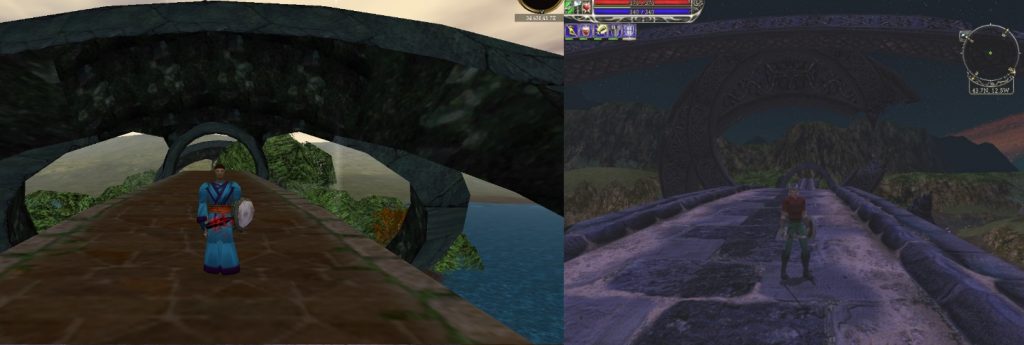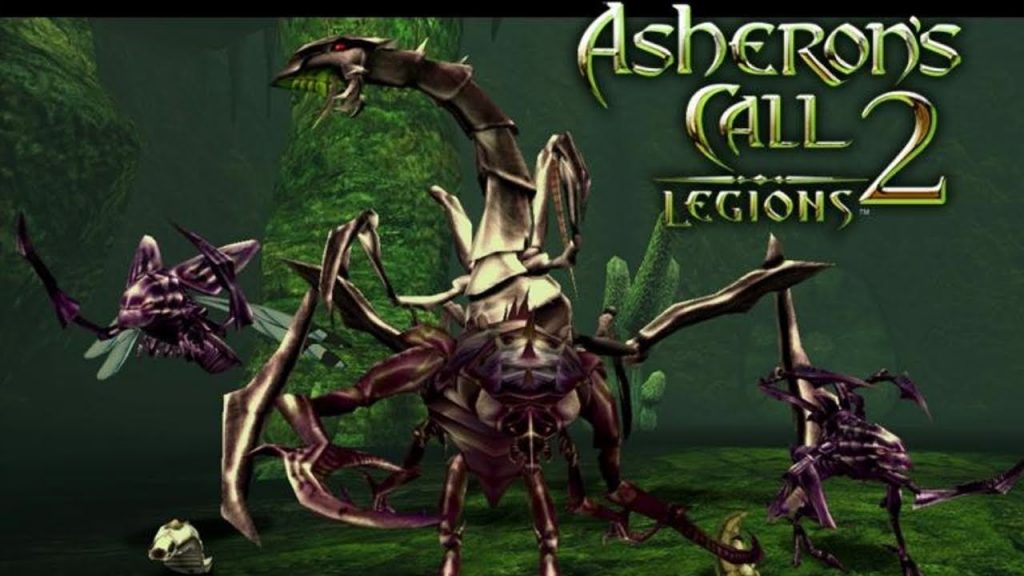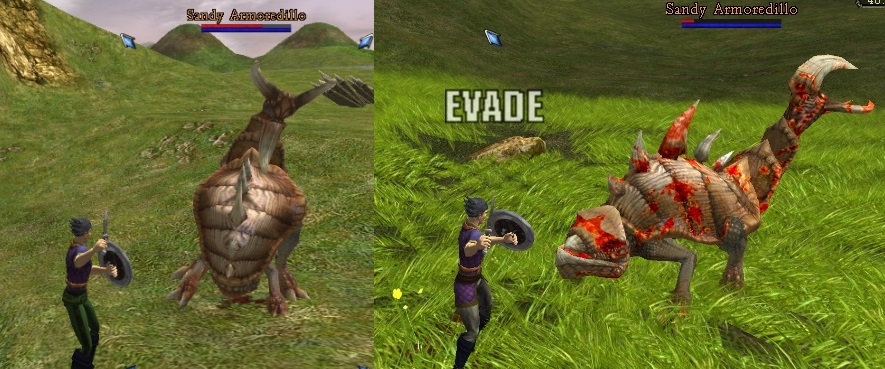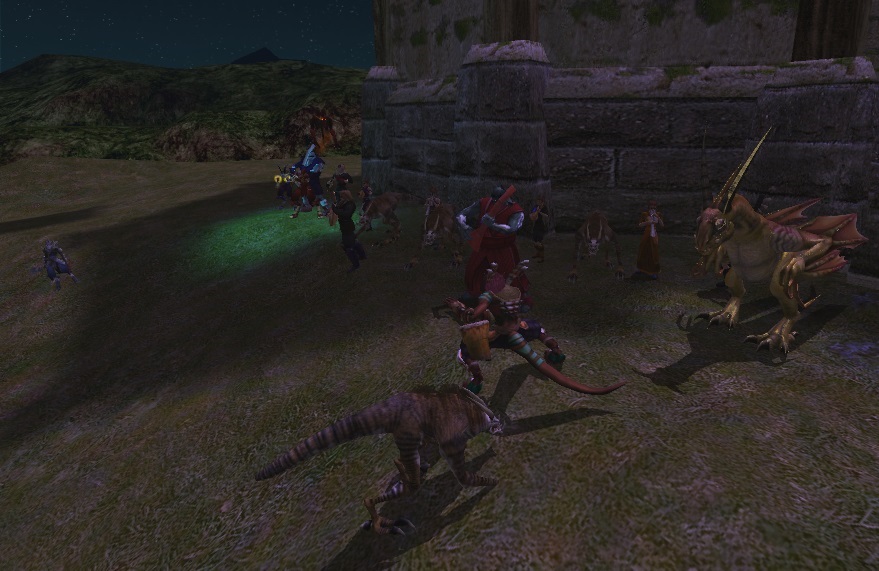
On the left in the screenshot above is a windmill in the town of Cragstone in Asheron’s Call. On the right is, well, the same windmill, but in the ruins of Cragstone hundreds of years later in Asheron’s Call 2’s. The latter game’s post apocalyptic setting is quite fitting, all things considered. The sequel was a mechanical departure from the original in many ways, but built on the same lore fans still crave. Not all Asheron’s Call fans would come along for the ride, but the sequel did find fans who never touched the original. AC2 also is about to go offline twice, so, well, there’s that. But there is a reason a sequel was made, and I’d wager the reason it went offline has more to do with the game’s broken past than its innovations.
Join me today as I take a look back through the history and highlights of Asheron’s Call 2. (The original game was the subject of a similar piece earlier this week, so don’t miss that either.)
A bridge too far?
The story of Asheron’s Call 2 states that the world was so ravaged by war, so twisted and dangerous, that the player races had to hide in shelters for generations before rising again. In a sense, it asked players to do the same. Not only did the characters we’d played as perish, as did most of the NPCs we loved, but so did certain practices.
As I’d previously mentioned, Asheron’s Call had its own problems. Its horribly obtuse controls and UI were difficult to navigate even in the old days. Magic was a terrifying system at first, but because it was so powerful and fairly useful, players broke it down and shared it freely, despite in-game mechanics trying to encourage the opposite. The flood of magic and free-form skill-building system not only allowed for hybrid characters but practically required them, as the game was largely solo-friendly and lacked an obvious taunt/detaunt system. While this meant Asheron’s Call was largely free of trinity play, it also meant that large encounters generally couldn’t utilize highly structured scenarios. While there was some strategy, such as using the correct elemental types to wield against enemies, creative use of collision detection and environment, attacking creatures with shields from the back to increase damage dealt, most fights could just be swarmed.
AC2, however, corrected some of these issues. While by today’s standards, AC2 has a rather dated UI (my horse for mouse-over stat windows!), I’d wager it’s more familiar to modern players. AC1 lacked a quest tracking system, and many of us were used to writing down coordinates and tips on scraps of paper around our computers. AC2, however, tracked quests. The walls of text we got from NPCs in AC1 would be summarized into a quest panel for AC2, both in terms of lore and goals. While AC1 had a map with points of interest that acted as a soft way to encourage people to explore, AC2‘s points were labelled more clearly, showing the type of location (dungeon vs. lore spot or town), plus the intended level range.
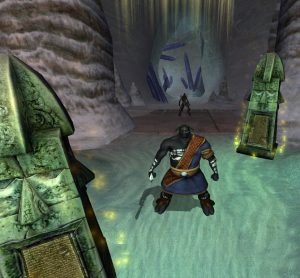 Stats were largely distilled and less static, making it harder to screw up character creation, though it did make being unique a little more difficult. You could still roll something a bit weird, like a tanky archer, but it was difficult. Whereas AC1 had specific weapon skills like for swords and axes followed by a general melee defense skill, AC2 combined all melee offense and defense skills into a single stat. Being good at attacking with magic meant being able to defend against it skillfully, which seems intuitive, but for creative types like yours truly, it was frustrating.
Stats were largely distilled and less static, making it harder to screw up character creation, though it did make being unique a little more difficult. You could still roll something a bit weird, like a tanky archer, but it was difficult. Whereas AC1 had specific weapon skills like for swords and axes followed by a general melee defense skill, AC2 combined all melee offense and defense skills into a single stat. Being good at attacking with magic meant being able to defend against it skillfully, which seems intuitive, but for creative types like yours truly, it was frustrating.
The controls, however, were easier. The game was set up with WASD movement in mind, keeping most important keys in that area (such as “use” being Z and “ID” being X). AC2 allowed for multiple action bars and in-game macro creation, both of which the original lacked (though supported through the modding community, the former being only needed by mages). Gone was AC1’s awkward number-pad controlled camera controls, replaced with a mouse focused option modern gamers are more familiar with.
Admittedly, crafting was dumbed down to what you’d see years later in World of Warcraft, but it was still randomized, like the loot system, and mostly used for leveling and eventually modifying random loot. Like AC1, AC2 was an anti-raiding game, focusing more on story and single encounters than requiring dungeon runs for chances at loot (raid-like dungeons were actually more useful for leveling). We even had more races at launch! AC1’s races were added years after AC2 went offline the first time, around 2010, and AC1 never got playable drudges — that hairless, cat-goblin hybrid thing of nightmares.
By bringing in a taunt system and some character creation limitations, AC2 could make combat more group-oriented. For example, one healer might be better at restoring vigor, the player resource needed for casting and using special abilities. Another might be better at single-target heals, and yet another would be good at group heals. The fun thing was that healers weren’t restricted to just healing, and the cooldowns and skill sets gave them access to other jobs. Within the previous example, one group healer might be more focused on keeping mob regeneration down while another group healer focused on abilities to remove debuffs. AC2 had more than tanks, healers, and DPS. Players could be burst single-target DPS or group DPS, percentage-based or direct-damage-based, buffers or debuffers, cleansers or mezzers, mobile pet classes or immobile turret tacticians. There was even a class that used wasps as part pet, part projectile.
In many ways, going from AC1 to AC2 was like moving from fantasy radio programs to a sci-fi movie series. Yes, we gave up imagination, but got something visually appealing and highly structured that felt much, much easier to share, especially because it was a more group-oriented game. More mobs were designed with higher HP and damage capabilities plus ranged attacks to encourage group play, while AC1 monsters tended to have shallow health pools. Since AC1 players almost universally had healing skills, and mobs were mostly melee-based and at the mercy of collision detection, players could whittle nearly anything down given enough time. Grouping actually was (and still is) one of the prime differences between the two games, which is probably why AC2 could attract players who never tried the original.
But many AC1 players disliked that change. Despite the fact that when AC2 launched, most “playable” character builds were nearly the same (the same three of the four magic schools plus whatever damage/ranged class they preferred), AC1 players liked their illusion of choice. They were used to being able to solo content and inviting other players, not so much to socialize but for group experience bonuses or help with corpse retrieval (the latter being removed from AC2). While some AC2 classes could eventually solo quite well, the path there generally required some grouping.
Logically, good grouping required a good chat system. AC2’s was anything but.
The worst kind of bugs
There are lots of reasons people talk about AC2’s failure, and many are fair. For one, AC1 was still around. As I said, it was a living, breathing world, and the updates at the time were still quite exciting. I remember playing AC2 but still checking AC celebrity and fellow Thistledown resident Maggie the Jackcat‘s webpage to keep up with the original’s ongoing living story events (in fact, it’s back online now!). It probably didn’t help that AC2 basically meant AC1 players would eventually fail, but hey, we AC2 players got access to creature types and eventually player races that would later trickle back down into AC1.
Then there was the mechanical differences. AC2 was a sequel that had the same lore presence, but with totally new systems. No more obtuse magic learning! Magic and non-magic were rolled into an easy to understand used-skills system, allowing non-mage combat to move beyond positioning yourself for optimal auto-attacking and healing into, well, what we see in most modern tab-target MMOs. We got group-based combat mechanics, rezzing, mezzing, faction based PvP, deeper crafting, a cool music system, and hey, we finally could swim! Combined with the lore issue, the original player base was split, but let’s be real: A good sequel should bring in new players, and AC2 did that.
The problem was bugs. Lots and lots of bugs, and I don’t just mean olthoi (which, initially, were only grubs, not the beasts above). As publisher of Turbine’s games back then, Microsoft had forced AC2 out well before it was ready. I remember being a tester and knowing that while there was some good pacing at the start of the game, there were issues with certain moves. Some classes were soloing when we were supposed to be a group-heavy game, while some were flat-out broken.
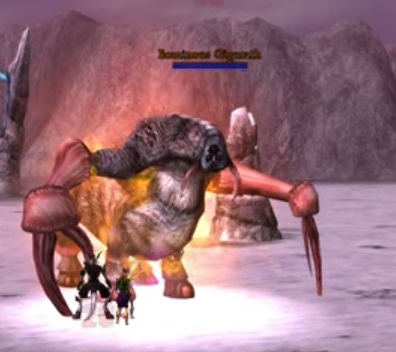 One big problem was the serious pathing AI issues, seen mostly through pets, but they started popping up more on the mid-level continent. This made certain pet classes nearly unplayable at launch. If someone didn’t notice it as a newbie, she’d see it as a high level, as giant dragons and elephant-crab-spider hybrids of doom would… well, get caught on some unseen terrain curb and stand there getting ranged to death by nude players. This happened constantly, without anyone even needing to try to exploit the game.
One big problem was the serious pathing AI issues, seen mostly through pets, but they started popping up more on the mid-level continent. This made certain pet classes nearly unplayable at launch. If someone didn’t notice it as a newbie, she’d see it as a high level, as giant dragons and elephant-crab-spider hybrids of doom would… well, get caught on some unseen terrain curb and stand there getting ranged to death by nude players. This happened constantly, without anyone even needing to try to exploit the game.
Furthermore, like any newly released game, AC2 lacked a lot of endgame content beyond PvP. While I personally loved this when I finally got there, AC1 was an essentially capless grindfest. No one was expected to reach the cap, so if an AC2 player capped out, disliked PvP, and didn’t want to reroll, he’d leave.
Worse, though, was the GUN system forced on the game by Microsoft. It was a chat system attached to other social tools (like the friend’s list) that constantly crashed. While the game was super visual, showing when an NPC’s “weakness” was exposed, floating buff icons on models, and blood/damage increasing on models to show how close they were to death, players needed to form groups. They needed to guide each other through the portal rings that made fast travel fast, go over strategies that AC1 players never had to learn, or just simply talk. When the GUN system failed, all communication fell too. You didn’t know who was logged in. You basically needed to be standing in front of someone to talk.
Chat was actually the biggest issue people complained about, both vets of the original AC and folks who started with the sequel. It was a central theme in Justin’s old interview with AC2 fansite managers. It’s actually what drove my group to use voice chat. Most of us were desirable group members in AC1 but ended up being group leaders or exploration teams; some even got “rented out” to other guilds for dungeon runs we’d outgrown. Communication and the teamwork it afforded was that important, and by denying it to the common player at the start of the game, Microsoft doomed Turbine’s game by forcing the launch.
Endgame and immersion
While AC2 lacked developer created content, I felt the series’ core strength was its lore. AC2 greatly benefited by being set in the future of a war-torn land many players were familiar with. There wasn’t specific support for roleplayers, but my group and I would roleplay anyway. One character had several gibberish sayings that people would learn to decipher based on context; another was a mute who gestured; yet another was a humble healer looking to help others but was often paired with a healer who doubted the group’s strength. And we were able to get others to join in. Recalling “ancient stories” was our way of talking about AC1 events, and people loved to do that during downtime. Remembering how a town used to look, wondering if the dragonic tyrants were related to AC1’s mythical and unseen gromnatross, debating how a minor zombie villain in the “golden age” of AC1 had beaten the old world’s faction leaders… people enjoyed that, even as we ran a dungeon for like hundredth time for someone’s alt.
Like AC1, AC2 had both collision detection and items existing persistently in the world. That is, if a player made a wall (some could do that), you had to either run around it or break it down. If you left a shield on the ground, another player could come pick it up. Arrows were no longer something we had to create, so they no longer appeared in the gameworld as items (a game feature people abused in AC1 for crashing servers and duping), but like other projectiles, they could still be avoided by physically moving away from their line of trajectory. This led to things like very real portal camping where people could be boxed in, as well as methods for tracking your path in a maze or the creation of impromptu player-made quests.
Knockback skills and slightly odd physics combined to make players fly through the gameworld. I remember exploring one area by getting a certain mob type to knock me back while I’d jump, sending me flying over mountains. It was admittedly one of the few things that broke immersion (aside from the fact that many buildings couldn’t actually be entered until years after release), but it was a lot of fun. In fact, my group and I would play with knockback skills in the free for all PvP zone, trying to see how far we could get people to fly. It was pretty enjoyable, even if I eventually “won” by sending my guild leader over a mountain, over a city, and far beyond the point of return in the middle of an ocean. Sorry, Kyn!
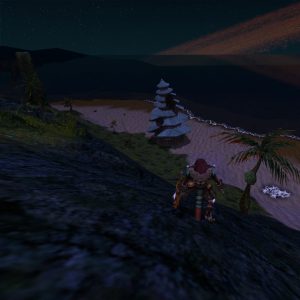 The slow pace of life at the level cap made PvP feel like a fun side game. It’s what got me into the PvP scene in the first place, as the game’s death penalty was less harsh. The faction system and its points gave me the illusion of a worthwhile risk vs. reward system, only broken when my faction became dominant and the other factions became too weak for me to gain anything from them (though I still risked losing points).
The slow pace of life at the level cap made PvP feel like a fun side game. It’s what got me into the PvP scene in the first place, as the game’s death penalty was less harsh. The faction system and its points gave me the illusion of a worthwhile risk vs. reward system, only broken when my faction became dominant and the other factions became too weak for me to gain anything from them (though I still risked losing points).
The ability to change factions felt meaningful, especially when live events would shake things up. I remember my group had a bit of a split when our faction was too powerful and an update, by chance, put more emphasis on that faction trying to regain their former glory. It wasn’t power related in terms of stats, just lore. Since monthly content was something we often finished within the first day or week, we could change our pace, then return to game politics.
I know many people like games feeling gamey, but the social systems, especially politics, truly ran AC2‘s endgame, much as you’d expect in a sandbox game. It helped make Dereth into a virtual world. Once the flaws in the faction point system were made obvious, the main reason to continue was to roleplay… or test grouping skills against other people.
As most chat channels were broken aside from the public “say” option, smart players had to use voice chat or speak aloud. The latter was often used, and it gave the game world a reason to have scouts. Radar detection would give you away, but finding the sweet spot between radar/visual detection and the ability to hear what was being said by your enemies was important, and it gave people a reason to stay in PvP flagged areas, so as to kill scouts. Combined with the game visually showing damage and effects on character models, AC2’s endgame was a PvP RPers dream.
Asheron’s Call 2’s Legacy
AC2 did a lot of things that pushed both the franchise and the genre. It was, perhaps, ahead of its time. A focus on questing, more hand-holding for world exploration, and in-game quest tracking were all features that made AC2 stand out at the time and ultimately made World of Warcraft successful, despite the fact that I still feel AC2 had better graphics and animations at the time. In fact, AC2 had cutscenes as “raid” rewards long before WoW introduced them, and AC2 put them on a UI panel that allowed you to rewatch them any time. In fact, logging into the patch gave you a cutscene to help explain what was new and going on, and I can’t think of many other MMOs that do this (Star Wars: The Old Republic is one!).
Voice acting, while reserved for cutscenes and mobs, also stood out. NPCs would literally call out for heals, assistance, and I think they also would tell their minions to “kill the one in the dress.” They even had racial hatreds and would make “racist” remarks, such as the stoic lugians’ racial enemies calling them “rock pushers.” This was during a time when voice acting in singleplayer games still felt exciting rather than rote. In fact, one of the first things that got me to smile while I recently returned to haunt AC2’s apocalyptic world was a drudge mage crying, “When I say ‘heal,’ I mean it!” before I ended him.
Well before Star Wars Galaxies, Lord of the Rings Online, and ArcheAge, AC2 had an interactive music system of its own. Sure, it was pre-formed multiple choice stuff and didn’t provide any stat benefit, but it was something you could do for fun, any time, anywhere. We no longer had Pong or Chess, but this was more immersive.
The tactician class, centered on using turrets as powerful stationary pets while protecting them with pet walls to physically prevent passage, is something not every MMORPG includes. It actually made spawn camping mobs fun.
While multiple MMORPGs through the years have provided dynamic or recurring world events player could find or activate, AC2 had certain areas where quests would start every, say, 30 minutes or so. In fact, one month-long event centered on city invasions. Most were outposts, but events in capital cities were part puzzle, requiring players to give the ghost of AC1 lore characters an item to help them recall their past and quiet their soul.
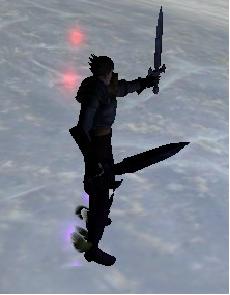 Like a lot of the earliest MMOs, AC1 offered live events led by developers, but it was a level-based game, and the average player wasn’t near the cap until Microsoft was ready to bury it. Getting mounts, new creature types, and learning the fate of the live game felt like a worthwhile trade during that first year.
Like a lot of the earliest MMOs, AC1 offered live events led by developers, but it was a level-based game, and the average player wasn’t near the cap until Microsoft was ready to bury it. Getting mounts, new creature types, and learning the fate of the live game felt like a worthwhile trade during that first year.
But AC2 also split its playerbase. It came out too soon and was the wrong kind of different for its day. It asked sandboxers to play something more themeparky in a world where true sandboxes thrived. It asked us to use more of a class-based system with levels than a almost pure skills/loot based system. Gamers used to soloing were now practically required to group up or face (for most classes) a horrible grind of dull, repetitive kill quests.
However, saying it was “too different” feels like a weak argument. Remember that Mario Kart Double Dash, while vastly different from previous iterations of the game, had the highest install rate to console sales of any other game in the series prior to the recent Mario Kart 8 for Wii U. I still argue it’s one of the more memorable games in the franchise, and I’d love to be able to say the same of AC2 should the IP ever get the sequels it deserves.

